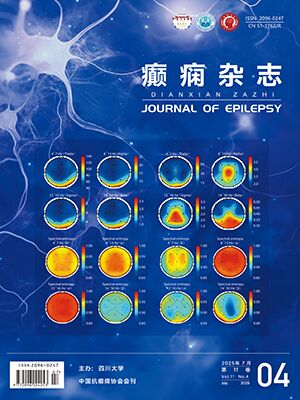| 1. |
EH Reynolds. ILAE/IBE/WHO Global Campaign "out of the shadows": global and regional developments. Epilepsia, 2001, 42(8): 1094-1100.
|
| 2. |
常琳.中国癫痫流行病学调查研究进展.国际神经病学神经外科学杂志, 2012, 39(2): 161-164.
|
| 3. |
Specchio LM, Beghi E. Should antiepileptic drugs be withdrawn in seizure-free patients?. CNS Drugs, 2004, 18(4): 201-212.
|
| 4. |
Verrotti A, D Egidio C, Agostinelli S, et al. Antiepileptic drug withdrawal in childhood epilepsy: what are the risk factors associated with seizure relapse?. Elsevier, 2012, 16(6): 599-604.
|
| 5. |
Dooley J, Gordon K, Camfield P, et al. Discontinuation of anticonvulsant therapy in children free of seizures for 1 year: a prospective study. Neurology, 1996, 46(4): 969-974.
|
| 6. |
Tinuper P, Avoni P, Riva R, et al. The Prognostic value of the electroencephalogram in antiepileptic drug withdrawal in partial epilepsies. Neurology, 1996, 47(1): 76-78.
|
| 7. |
Hawash KY, Rosman NP. Do partial seizures predict an increased risk of seizure recurrence after antiepilepsy drugs are withdrawn?. Journal of Child Neurology, 2003, 18(5): 331-337.
|
| 8. |
Altunbasak S, Artar O, Burgut R, et al. Relapse risk analysis after drug withdrawal in epileptic children with uncomplicated seizures. Seizure, 1999, 8(3): 384-389.
|
| 9. |
Olmez A, Arslan U, Turanli G, et al. Risk of recurrence after drug withdrawal in childhood epilepsy. Seizure, 2009, 18(4): 251-256.
|
| 10. |
Camfield P, Camfield C. The frequency of intractable seizures after stopping AEDs in seizure-free children with epilepsy. Neurology, 2005, 64(20): 973-975.
|
| 11. |
Shinnar S, Vining EP, Mellits ED, et al. Discontinuing antiepileptic medication in children with epilepsy after two years without seizures: a prospective study. N Engl J Med, 1985, 313(8): 976-980.
|
| 12. |
Emerson R, D Souza BJ, Vining EP, et al. Stopping medication in children with epilepsy: predictors of outcome. N Engl J Med, 1981, 304(7): 1125-1129.
|
| 13. |
Tennison M, Greenwood R, Lewis D, et al. Discontinuing antiepileptic drugs in children with epilepsy. N Engl J Med, 1994, 330(20): 1407-1410.
|
| 14. |
Mastropaolo C, Tondi M, Carboni F, et al. Prognosis after therapy discontinuation in children with epilepsy. Eur Neurol, 1992, 32(9): 141-145.
|
| 15. |
Matricardi M, Brinciotti M, Benedetti P. Outcome after discontinuation of antiepileptic drug therapy in children with epilepsy. Epilepsia, 1989, 30(5): 582-589.
|
| 16. |
Ramos-Lizana J, Aguirre-Rodríguez J, Aguilera-Lopez P, et al. Recurrence risk after withdrawal of antiepileptic drugs in children with epilepsy: a prospective study. Eur J Paediatr Neurol, 2010, 14(2): 116-124.
|
| 17. |
Juul-Jensen P. Frequency of recurrence after discontinuance of anticonvulsant therapy in patients with epileptic seizures: a new follow-up study after 5 years. Epilepsia, 1968, 9(1): 11-16.
|
| 18. |
Sillanpaa M, Schmidt D. Prognosis of seizure recurrence after stopping antiepileptic drugs in seizure-free patients: a long-term population-based study of childhood-onset epilepsy. Epilepsy & Behavior, 2006, 8(4): 713-719.
|
| 19. |
Schmidt D, Loscher W. Uncontrolled epilepsy following discontinuation of antiepileptic drugs in seizure-free patients: a review of current clinical experience. Acta Neurologica Scandinavica, 2005, 111(5): 291-300.
|
| 20. |
Arts WF, Visser LH, Loonen MC, et al. Follow-up of 146 children with epilepsy after withdrawal of antiepileptic therapy. Epilepsia, 1988, 29(50): 244-250.
|
| 21. |
Shinnar S, Berg AT, Moshe SL. Discontinuing antiepileptic drugs in children with epilepsy: A prospective study. Annals of Neurology, 1994, 35(5): 534-545.
|
| 22. |
Overweg J, Binnie CD, Rowan AJ, et al. Clinical and EEG prediction of seizure recurrence following antiepileptic drug withdrawal. Epilepsy Res, 1987, 1(5): 272-283.
|
| 23. |
Medical Research Council Antiepileptic Drug Withdrawal Study Group. Randomised study of antiepileptic drug withdrawal in patients in remission. Lancet, 1991, 337(8751): 1175-1180.
|
| 24. |
Donati F, Hassink RI, Vassella F, et al. Factors predicting the risk of relapse after antiepileptic drug discontinuation in children with partial seizures. Eur J Pediatr, 1995, 154(Suppl 1): 44-47.
|
| 25. |
Strozzi I, Nolan SJ, Sperling MR, et al. Early versus late antiepileptic drug withdrawal for people with epilepsy in remission. Cochrane Database Syst Rev, 2015, 132(2): CD001902.
|
| 26. |
Cardoso TA, Cendes F, Guerreiro CA. Is low antiepileptic drug does effective in long-term seizure-free patients. Arq Neuropsiquiatr, 2003, 61(3A): 566-573.
|
| 27. |
苏凌璎, 狄晴, 余年, 等.不同撤药时机对癫痫患者复发的影响.中华神经医学杂志, 2012, 11(10): 982-985.
|
| 28. |
Serra JG, Montenegro MA, Guerreiro MM. Antiepileptic drug withdrawal in childhood: dose the duration of tapering off matter for seizure recurrence. J Child Neurol, 2005, 20(7): 624-626.
|
| 29. |
Ranganathan LN, Ramaratnam S. Rapid versus slow withdrawal of antiepileptic drugs. Cochrane Datebase Syst Rev, 2006, 19(2): CD005003.
|
| 30. |
王凌玲, 苏凌璎, 狄晴, 等.不同撤药速度对癫痫患者复发的影响.中国神经精神疾病杂志, 2012, 38(12): 716-719.
|
| 31. |
李维, 周东.癫痫撤药相关问题.中国神经精神疾病杂志, 2013, 39(6): 382-384.
|
| 32. |
Verrotti A, Morresi S, Cutarella R, et al. Predictive value of EEG monitoring during drug withdrawal in children with cryptogenic partial epilepsy. Neurophysiol Clin, 2000, 30(4): 240-245.
|




